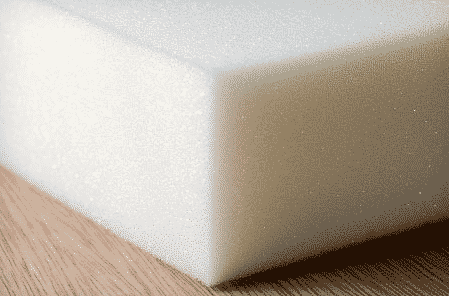Polyurethane (PU) was first developed in 1937, but it was not until 1954 that the foam variety was created to add an upholstery layer to innerspring mattresses. Today, it is widely used in mattress construction and has become a very popular option for support cores. With differing density and resiliency ratings, it appeals to a wide variety of consumers.
What is Polyurethane Foam?
To create polyurethane, foam polyps, or modified oil molecules, are linked to isocyanates or other large molecules. The polyps are typically petroleum-derived, and sometimes, catalysts, surfactants, and other additives are also used. Don’t worry; there is no need to take a crash course in chemistry to get a little more familiar with polyurethane. All there is to know is that by modifying ingredients and processes, polyurethane foams can be produced with a variety of properties, from conforming to rigid and ultra-plush to firm. This allows them to appeal to the sleep environment preference of nearly anyone.
Regular Conventional Polyurethane
This is the least expensive variety and one that is recommended to avoid, if possible. It weighs less than 1.5 pounds per cubic foot, making it the lowest grade PU available.
It is not suitable to provide support or offer comfort. It also breaks down fast and will need to be replaced quickly. It is better to spend a little more on a higher quality product that will last longer, so customers are really getting their money’s worth out of it.
High Density (HD) Polyurethane
This is a step up from conventional, as it usually weighs 1.5 pounds per cubic foot, but can reach the 2-pound range. It lasts longer and retains its firmness longer than conventional varieties, but not as long as higher grades of PU or quality innerspring support cores.
High-density polyurethane is fairly inexpensive to manufacture, so it is a popular pick in support layers, and this includes higher-end mattresses. It does not hold one up quite as well as higher grades, but it is a fantastic support to quality comfort layers.
High Resiliency (HR) Polyurethane
Weighing at least 2.5 pounds per cubic foot, this is the highest grade one will find used in mattress support cores. It boasts a completely different formulation than the other two varieties. It is more expensive to manufacture, but it is also more durable, resilient, and supportive, and it is more resistant to softening. This is a great alternative to those wanting the comfort of latex at a price that is just a bit easier on the wallet. Since 1978, high resilience foam has been distinguished on mattress law labels. HR foams need to be recognized by the Association of Bedding and Furniture Law officials, and they must exceed minimal standards. Unless a mattress label actually states that it is high resiliency, customers should assume that it is the high density or conventional polyurethane foam.
- Density – This type of polyurethane foam must have a minimum density of 2.5 pounds per cubic foot to wear the HR label.
- Resilience – To measure resilience a steel ball is dropped from a specific height onto the foam. It has to rebound the ball by at least 60% of the drop height.
- Support Factor – This ratio represents the pounds needed to compress the foam to 65% of its height divided by the pounds needed to compress to 25% of its height. High resilience polyurethane foam needs a minimum ratio of 2.4:1.
High Performance vs. Conventional
Structure and flexibility represent two of the biggest differences one will find between conventional and high-performance polyurethane foam used to manufacture support cores. High-performance varieties provide significantly greater engineering flexibility. These formulations improve surface liveliness and mattress support. They can also help softer foams perform better with less fatigue.
A network of interlocking elastic cavities and struts forming cell structures comprise flexible polyurethane foam. Conventional polyurethane has a fine and consistent cell structure while high-performance varieties are characterized by random-sized and fairly coarse cells.
The smooth cells associated with conventional foam have one disadvantage. Since cells have similar structures and cavities, they all collapse at the same rate when pressure is applied. Since high-performance polyurethane foam has cells that are diverse structures and sizes, they provide a variety of functions simultaneously. For example, those with developed struts provide buoyant support to prevent “bottoming out” while fine cells give way to provide a plush surface. The combined effect of varying strut diminishes and cavity sizes create a unique cradling feel that is also very supportive.
Plant-Based Polyurethane
Manufactured from natural fibers, plant-based polyurethane foam has become quite popular in the mattress industry. It is typically made from bamboo, hemp, or kelp, and it is highly resistant to heat, moisture, mold, and pests.
Plant-derived oils are used for 15 to 20 percent of polyps in this foam. Soy oil is the most popular option, but palm and coconut oils are also sometimes used. This type of foam is thought of as being eco-friendly, and it usually is chemical-free, which is good news to allergy and asthma sufferers. However, there is still criticism and debate over the “green” claims made by some manufacturers of plant-based polyurethane. The argument really heats up if coconut or palm oil is used because these are not sustainable crops. They deplete the rain forest at a rapid rate. So, although greenhouse gases are not emitted, customers still have to consider the materials used during construction.
Final Thoughts
The standout characteristic of polyurethane foam is that it is resistant to body impressions, which is the loss of height caused by mattress fatigue. It can often feel as though people aren’t sleeping on a bed at all if they are using the right mattress. Adding a support core that is the right firmness can make it significantly more comfortable while also extending its life. Thanks to the regularity of PU, the amount it will compact over time can be predicted by laboratory tests. Polyurethane typically loses up to 20 percent of its firmness, but this happens quite early as part of a settling process. Once this takes place the foam remains fairly consistent for many years.


